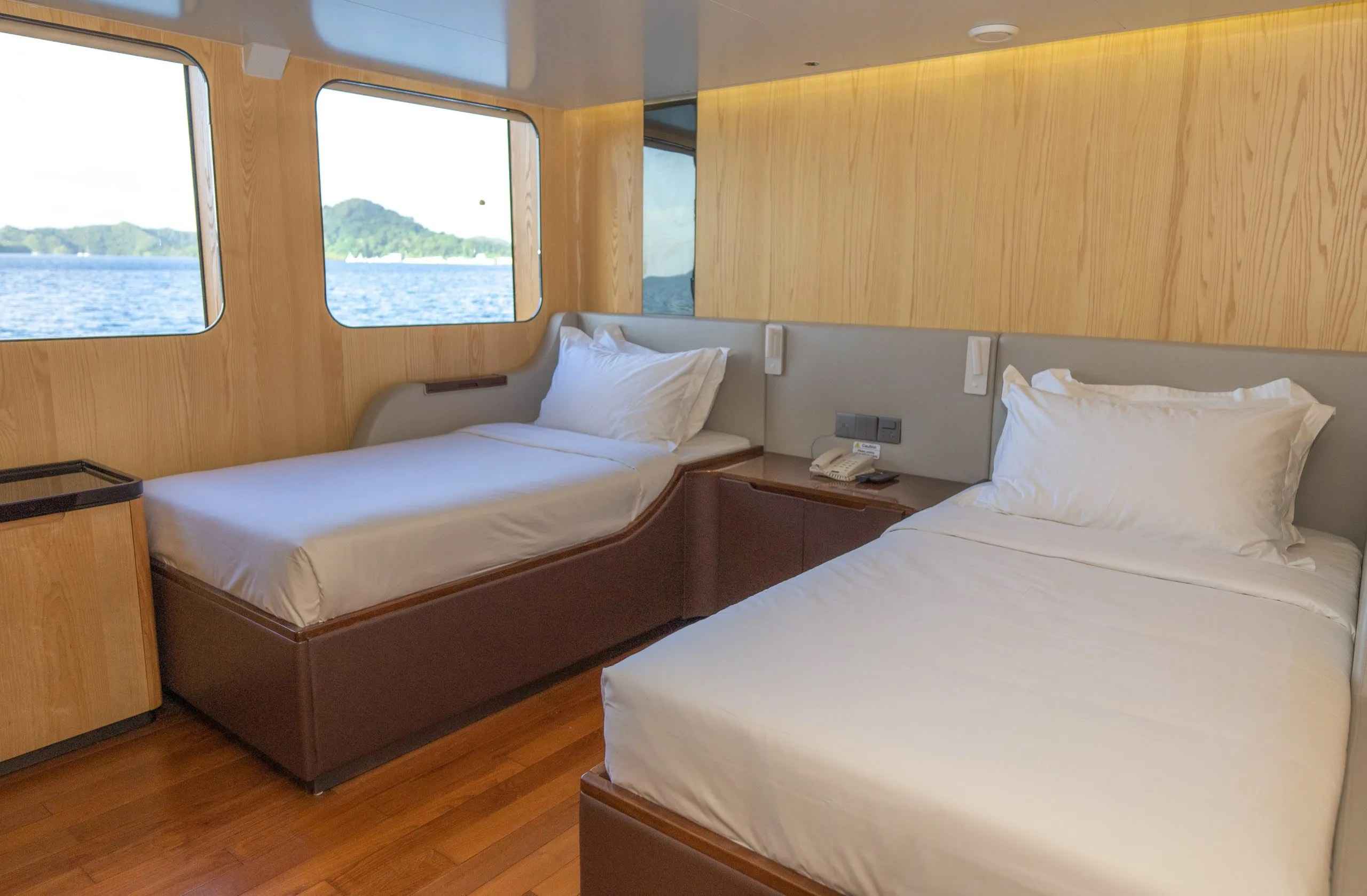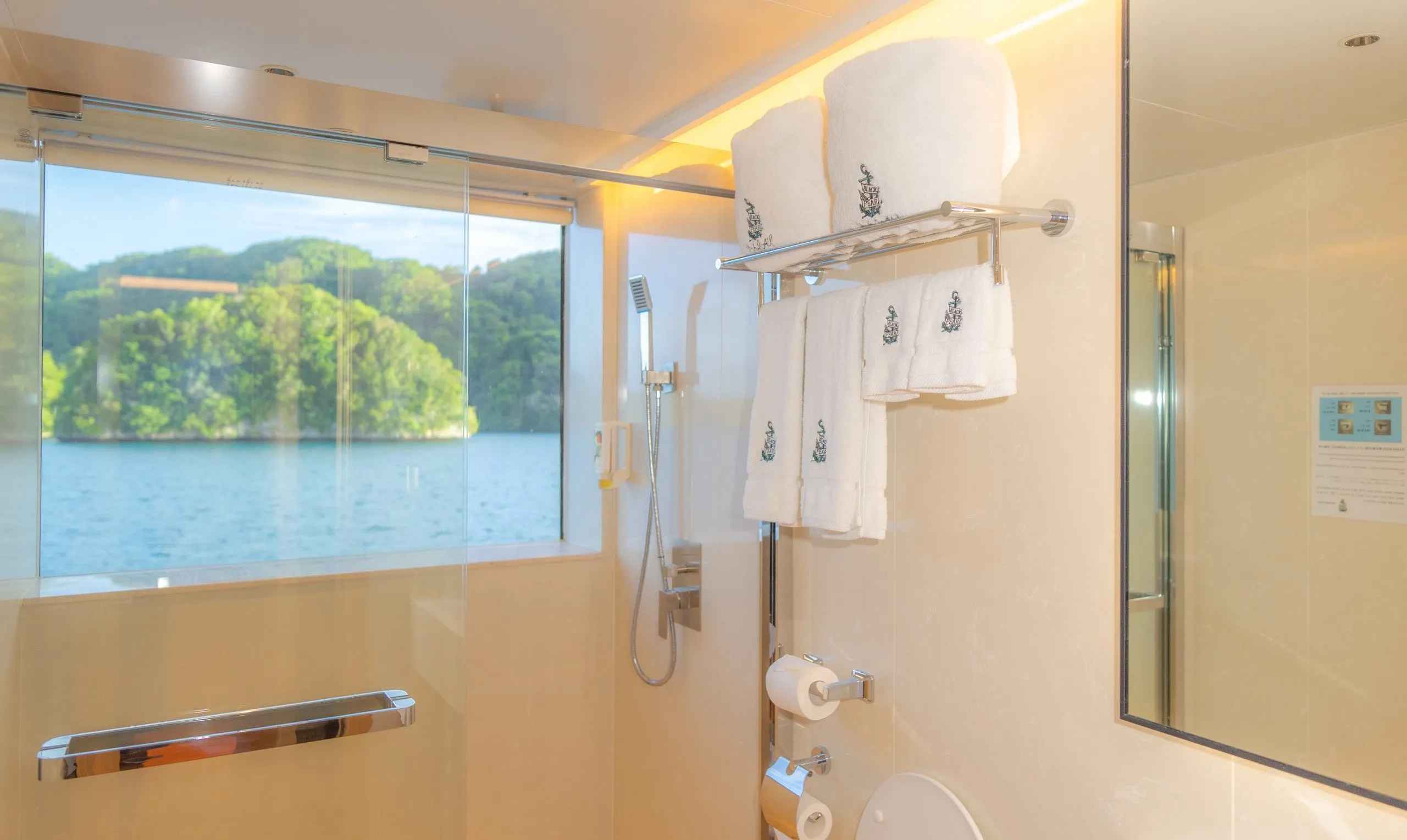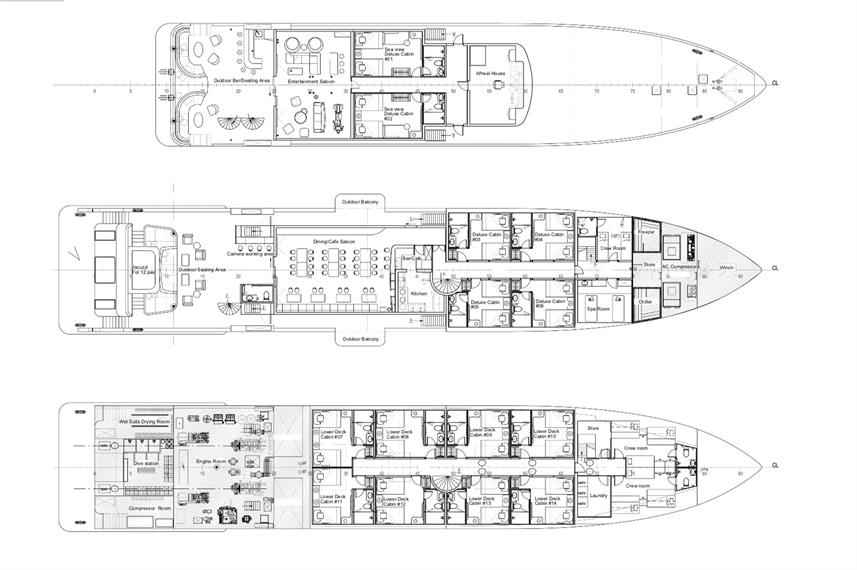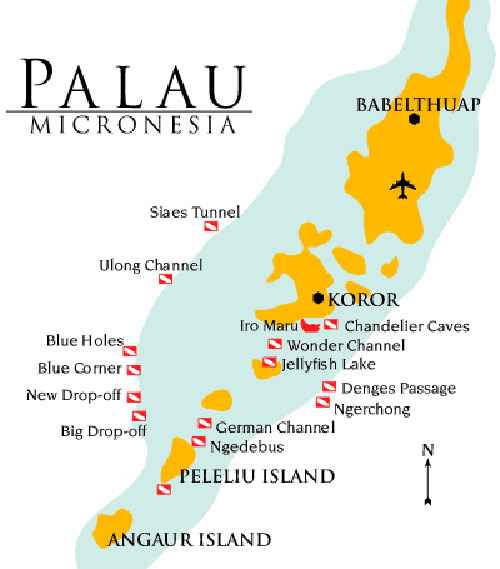Cayman Brac Beach Resort
M/Y Black Pearl I offers one week dive cruises to the best sites around Palau. She was built to meet the standard requirements of the International Integrity Stability Standard for yachts above 46-meters. The vessel is fitted with premium materials and the latest navigation, safety and scuba diving systems and equipment to exceed high standards in the yachting industry. There are 10 twin cabins accommodating 22 guests and a Master Cabin with a double bed. There are spacious social areas including a large sun deck with beach beds, tanning benches and a 6 person jacuzzi. The outdoor terrace located at the back of the boat is ideal for a sundowner and to reflect on the day’s adventures.
Their commitment to all guests is to provide a world-class experience onboard M/Y Black Pearl I, cruising across the pristine waters of Palau, Micronesia. With state-of-the-art design and functionality, The captain and crew of Black Pearl prides themselves in providing top amenities and comfort for a memorable stay for all guests alike.
Vessel Amenities
Main Deck Outdoor Seating and Jacuzzi
Main Deck Outdoor Bar
Spacious Indoor Dining Area with Cafe and Bar
Entertainment Salon with Gym Equipment, Business Centre
Camera station
Sun Deck Seating and Sun Beds
Cabins
11 Ensuite Cabins with Hot Shower
Twin Share Cabins with Beds 2000 x 1200 x 400 / Master has a double bed.
Hassle-Free Keypad Door Lock Systems
Basic Room Amenities: 2-in-1 Shampoo and Bath Gel, Separate Towel Hangers for Bath and Face Towels, Clothes Hooks, Hair Dryer, Safety Deposit Box, USB Ports for Charging, Inter-Room Communication System

Diving
2x tenders
12-Diver Capacity Boats
Boats with safety equipment
Classic Route - 8 days / 7 nights
The following is a sample itinerary, the boat may visit during your trip with the Black Pearl. If possible, try to coming during a Full Moon during Spawning Seasons! The dive team wishes to show you the very best diving possible, however, there are a number of factors determine which route the vessel takes and which dive sites selection.
Weather, tides, currents, and the number of other dive vessels at a particular site all play a part in the Cruise Director’s decision of where the Black Pearl is heading to. While they attempt to ensure the number of dives on the schedule is fulfilled, bad weather can hinder the vessel’s ability to reach a specific dive site in good time.
The safety of guests onboard is paramount and they always do their best to offer diving at alternate locations, should they be unable to visit those famous sites listed below.
The Dive Team will schedule up to 4 dives per day; 3-day dives and either a sunset or a night dive. A typical diving day is scheduled as follows:
Light snacks with morning coffee & tea followed by a briefing. Dive 1
Full Breakfast, surface interval followed by a briefing. Dive 2
Lunch, surface interval followed by a briefing. Dive 3
Snack & beverage break
Briefing for Sunset or Night dive
Dinner
Guests have to check their own flight times and ensure that they leave a minimum of 24 hours between their final dive and their departure flight.
ROCK ISLANDS & JELLYFISH LAKE TOUR
During the cruise journey, we’ve included 2 key interesting tourism attraction visits within our itinerary which are the Rock Islands and stopping by at the world-famous Jellyfish lake that is only recently re-open to the public!
BLUE CORNER
The most famous dive site in Palau is Blue Corner, the corner is a flat plateau, running a couple of hundred yards out to sea before dropping off abruptly, the wall is vertical and deep and is known for its sheer abundance of underwater life.
There are large pelagic fishes, here you can not only expect to meet great numbers of Jacks, Big Eyes/Blue Fin Trevallies, Black Fin Barracudas and Snappers, but you’ll also see Sharks, Tunas, Wahoo, Groupers, Eagle Rays, Hump head Wrasses, Green Turtles, and Hawksbill Turtles—All in a single dive!
Leafy Scorpionfish, Nudibranchs, Moray Eels, Lionfish, Boxing Crab, Anemone Fish, Hard corals; Soft corals; and Huge Gorgonian Sea fans. And if you’re lucky you may even see manta rays or sailfish and perhaps even a whale shark! Bigger pelagic are occasionally seen at the deeper reaches of Blue Corner: Hammerheads, Bull Sharks, Tiger Shark, Marlin, and Whales.
Like many other major dive sites, the strong tidal currents nourish this chain of life at Blue Corner are what make it so special. The dive site is suitable for advanced divers.
BLUE HOLES
Blue Holes is a huge cavern on the north side of Ngemelis Island, Next to Blue Corner. A large cavern with multiple entrances, accessible from the shallow reef top as well as deeper points on the wall. Illuminated by shafts of sunlight from overhead, the view from inside is a memorable experience of sublime beauty. Four big holes (about 5 × 3 meters each) on the ceiling enable a lot of ambient light to penetrate the cave and create great photo opportunities, you can swim towards the holes for some good silhouette shots.
Enjoy the Blue Hole experience at depths of 20 to 25 meters as well as the spacious main cavern is appropriate for divers of all experience levels, but there’s also a narrow cave at 26 meters’ depth. That should only be explored by properly equipped and certified cave divers.
The reef itself is another attraction surrounding both sites, with colonies of boulder and Cabbage corals scattered over the plateau at 18 meters. Dropping over the wall, you’ll find a healthy mix of hard and soft corals, as well as Sponges and massive Gorgonian sea fans.
Special critters that can be found inside the Blue Holes are the Flaming Scallop, Leafy Scorpionfish, Dart Fish, Nudibranchs, and Cleaner Shrimps.
CHANDELIER CAVE
Chandelier Cave was once an open-air cave dive site is a large cave with several chambers. You can enter the cave at 8 meters, and surface in several different chambers. Underwater tunnels allow you to swim from chamber to chamber with air pockets which 4 of the chambers are water-filled.
This is a very cool place, over the millenniums, rainwater, percolating down through the limestone, eroded the interior of the islands, forming vast cave systems. A good place to take a wide-angle photo with a diver, the crystalline formations hang from ceilings with the grace and beauty of the finest chandeliers.
It’s a very adventurous dive, bear in mind that this is an overhead environment—there are places where you can’t see any light, visibility can drop to zero, and divers must be equipped with a diving torch and divers who are claustrophobic and concerned with diving in darkness should avoid this dive.
GERMAN CHANNEL
German channel is famous for its Reef Mantas, Eagle Rays, Garden Eels, Snappers, Barracudas, Trevallies, Reef Sharks, and many species of Schooling Fishes. This narrow pass separates Ngemelis and Ngercheu Islands, forming a connection between the inner lagoon and the open sea.
German Channel is a man-made shallow channel that connects the lagoon with the outer reef. The channel was blasted by the Germans in the early 1900s in order to transport the excavated phosphates from the island of Angaur to the Koror port.
Today, many Manta Rays visit the channel and feed on the plankton that the strong currents bring. Few cleaning stations in the channel’s mouth allow one to view those great creatures from such a short distance. The cleaning station is at 18m and the beautiful coral garden at 7-13m.
Be extremely cautious when surfacing, however, as boating traffic can be very heavy here. Make sure you send up a safety marker buoy (SMB) on a line before your final ascent.
THE NGEMELIS WALL
The Ngemelis Wall is considered to be one of the world’s best wall dives. Starting in water just knee-deep, the wall drops off vertically nearly 300 meters. Close to the mooring buoy, a large chain connected to a 2 meters’ steel sphere can be seen, this chain and ball were used during WWII to prevent the Japanese from entering the waterway leading to German Channel. Divers can free-float past a brilliant rainbow of sponges and soft corals whose intense blues, reds, or pure whites form a backdrop for quivering 3 meters’ large orange and yellow Sea Fans and Giant Black Coral trees. Schools of Pyramid Butterfish, Sergeant Major fish, Yellowtail Fusiliers, Moorish idols, Angel Fish, Leaf fish, Stonefish, Lionfish, Green, and Hawksbill turtles. Reef Sharks, Nurse, and Leopard Sharks can be seen sleeping on the sandy bottom.
ULONG CHANNEL (NGERUMEKAOL PASS)
Ulong Channel, which many divers regard as one of the world’s best drift dives, is located on the west side of Ulong Island and incoming tide is generally best to see sharks, one of the best adrenaline high dive sites in Palau. It is known for its strong currents, seasonal spawning activity, and gliding sharks, a narrow 50-meter-wide channel that splits a part of a huge plateau in two, most clear, visibility up to 30 meters during the incoming tide.
You can enjoy beautiful corals, Napoleon Wrasse, Stingrays, Snappers, Jacks, Groupers' big school of Butterflyfish and yellowtail fusilier as well as turtles. A channel’s mouth, stop to check out the action of Reef Sharks and Barracudas gliding past while you hooking on.
Unhook and ride the currents into the channel, drifting throughout the average 10-meter depth sandy bottom with coral formations, fish of all kinds, and potentially sharks cruising through the narrow channel, and one of the most picturesque is a huge lettuce coral garden surrounded with squirrelfish and soldierfish.
Between April and July, the channel is also a spawning ground for thousands of Marbled Groupers during the full moon. Pay attention to Titan Trigger Fish as they can be quite aggressive especially when you’re near their nest.
HELMET WRECK
Helmet Wreck is a treasure trove of war materials and ship artifacts; this Japanese coaster was sunk during WWII and Helmet Wreck is definitely a “must-do” wreck in Palau. The stern rests at about 15 meters, while the bow is at 33 meters. It takes its name from the stacks of helmets you’ll see in the aft hold; they are now cemented together after decades of underwater corrosion. Other notable features include rifles, ammunition boxes, drums, pans, bottles, electrical parts, old sake bottles, depth chargers, and a few gas masks.
The holds are easily accessible since they’re all wide open, inside the hold in the bow, you can see engines for Zeke fighter planes together with electronic equipment.
Remember to not touch anything since there still are explosive ammo and depth chargers lying around.
SIAES CORNER/TUNNEL
Siaes Corner is one of Palau’s famous walls, at about 20 meters’ divers encounter one of the tunnel’s openings. At least about 4 x 6 meters wide and the opening gives entrance to a large cavern. The outside wall drops vertically to around 45 meters before it slopes off hundreds of meters to the ocean floor.
One should expect to see large numbers of Sharks, Jacks, Snappers, Trevallies, Turtles, and Stingrays in and around the tunnel.
Inside the tunnel, multicolor soft and hard corals adorn and fan the wall. On the sandy bottom, resting stingrays and white tips reef sharks are commonly seen. Rare types of angelfishes (Blue-Black Pygmy Angelfish, Colin’s Angelfish), and gobies and shrimps normally inhabit the sandy cave floor inside the tunnel.
The diver is advised to bring an underwater torchlight to better explore the tunnel.
PELELIU WALL
Peleliu Express is located at the southern tip of Peleliu island where the open ocean currents come together at the southern tip of the archipelago.
It is exposed to strong ripping converging currents that attract big critters, including Reef Sharks, Giant Groupers, Napoleon Wrasse, Barracudas, Tuna, Surgeonfish, Rainbow Runners, Spanish Mackerel and Eagle Rays. If you’re lucky, rare visits by Pilot whales, Sperm whales, Whale sharks, Hammerheads, Orcas, and Sailfish have been seen on this site.
Peleliu Express has reached cult status in the diving community and offers some of the best drift dives in the Pacific. The plateau wall is covered with beautiful corals of the soft and hard varieties, and bustling many different schools of tropical fish commonly found throughout Palau.
The ripping currents are unpredictable and often change without advanced warning, the experienced diver can experience over 4 knots currents on a regular basis. This site is suitable for experienced divers only.
PELELIU EXPRESS
Peleliu Express is a fantastic wall dive off the southern tip of the island, this dive site is on a section of the reef that is well known for its extremely fast drift dives with some of the strongest currents in Palau. It is part of the Peleliu wall, which is the deepest known reef in Palau. It provides divers with a fantastic experience of moving fast along the wall with a guarantee of seeing many different corals and a huge variety of marine life.
Divers will be able to see huge Gorgonian Sea fans along the wall as well as other soft corals, anemones, sea whips, and many hard corals. Divers will be surrounded by Barracuda, Jacks, Eagle Rays, Turtles, Snappers, Bump head parrotfish, Napoleon Wrasses, and Reef Sharks that are drifting with the current.
Potentially divers can also spot Bull sharks, Tiger sharks, Hammerheads, and Whales. Divers can stop in parts of the wall to explore many overhangs, crevices, and caves, which are carved by the constant tidal action and hold gardens of Gorgonians and Sea whips, which have lots of hidden marine life.
Because of the strong currents, this site is suitable for advanced divers only.

For more information on the trip, click HERE
